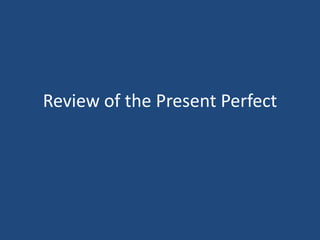
Review of the present perfect
- 1. Review of the Present Perfect
- 2. (Use #1) Use the present perfect with for or since for an action that began in the past and is still happening now.
- 3. For example: Ms. Agard has taught at Laney since 1997. She has lived in California for about thirty-five years.
- 4. When you use the present perfect in this way, you can usually also use the present perfect continuous:
- 5. For example: Ms. Agard has been teaching at Laney since 1997. She has been living in California for about thirty-five years.
- 6. But remember that some verbs can never be in the continuous tense:
- 7. For example: She has had a dog for the past ten years. NOT **She has been having a dog for the past ten years.
- 8. And
- 9. With “for” or “since”, the present perfect and the present perfect continuous mean the same thing: We have studied the past tenses since last week = We have been studying the past tenses since last week.
- 10. BUT
- 11. Without “for” or “since,” the present perfect and preset perfect continuous have different meanings: We have studied the past tenses = We studied the past tenses (at some time in the past.) We have been studying the past tenses (we started studying them in the past, and we are still studying them.)
- 12. (Use #2) Use the present perfect with ever, never and always:
- 13. For example: Have you ever played baseball? I’ve never played baseball, but I’ve always enjoyed watching baseball games.
- 14. (Use #3) Use present perfect for an action repeated in the past, which you think is likely or possible again in the future:
- 15. For example: New Orleans has had many hurricanes. I have been to Los Angeles three times.
- 16. (Use #4) Use present perfect with “just” or “recently” for an action that was completed very recently:
- 17. For example: I’ve just/recently had a cold. He has just/recently gotten a new job.
